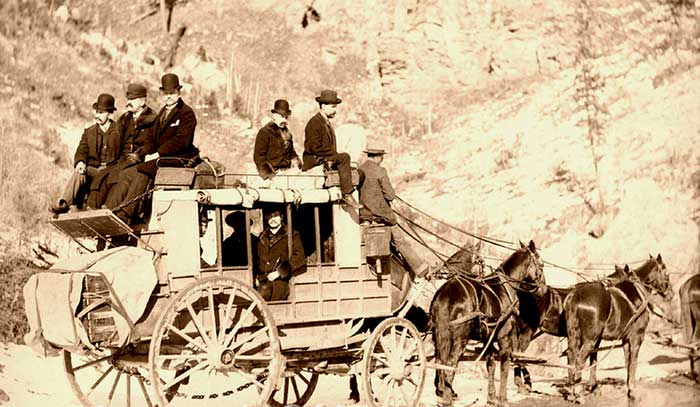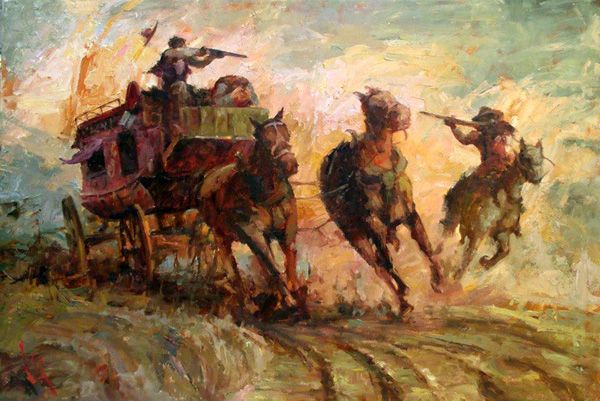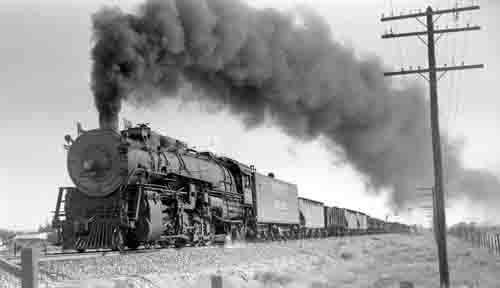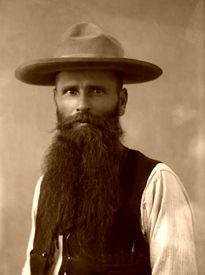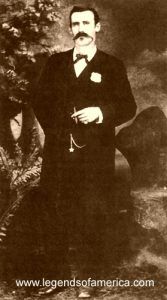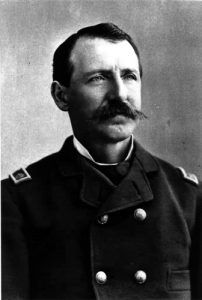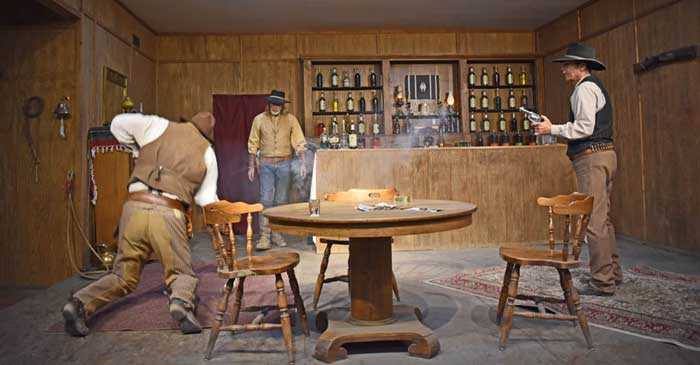
Gunfight re-enactment in Tombstone, 2021. Photo by Kathy Alexander
Triggerfingeritis is an acute irritation of the sensory nerves of the index finger of habitual gun-packers; usually fatal — to someone.
By Edgar Beecher Bronson in 1910
On the Plains in the late 1800s, there were two types of man-killers, and these two types were subdivided into classes.
The first type numbered all who took life in contravention of the law. This type was divided into three classes: A, Outlaws to whom blood-letting had become a mania; B, Outlaws who killed in defense of their spoils or liberty; C, Otherwise good men who had slain in the heat of private quarrel, and either “gone on the scout” or “jumped the country” rather than submit to arrest.
The second type included all who slew in support of law and order. This type included six classes: A, United States Marshals; B, Sheriffs and their deputies; C, Stage or railway express guards, called “messengers”; D, Private citizens organized as Vigilance Committees — these often none too discriminating, and not infrequently the blind or willing instruments of individual grudge or greed; E, Unorganized bands of ranchmen who took the trail of marauders on life or property and never quit it; F, Detectives for Stock Growers’ Associations.
Throughout the 1870s and well into the 1880s, in Wyoming, Dakota, western Kansas and Nebraska, New Mexico, and West Texas, courts were idle most of the time, and lawyers lived from hand to mouth. The then state of local society was so rudimentary that it had not acquired the habit of appeal to the law for the settlement of its differences. And while it may sound an anachronism, it is nevertheless the simple truth that while life was far less secure through that period, average personal honesty then ranked higher and depredations against property were fewer than at any time since.
As soon as society had advanced to a point where the victim could be relied on to carry his wrongs to court, judges began working overtime and lawyers fattening. But, of the actual pioneers who took their lives in their hands and recklessly staked them in their everyday goings and comings (as, for instance, did all who ventured into the Sioux country north of the Platte River between 1875 and 1880) few long stayed — no matter what their occupation — who were slow on the trigger: it was back to Mother Earth or home for them.
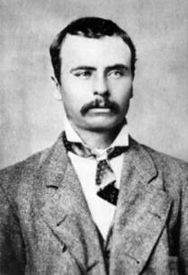
Boone May
Of the supporters of the law in that period, Boone May was one of the finest examples any frontier community ever boasted. Early in 1876 he came to Cheyenne, Wyoming with an elder brother and engaged in freighting thence overland to the Black Hills. Quite half the length of the stage road was then infested by hostile Sioux. This meant heavy risks and high pay. The brothers prospered so handsomely that, toward the end of the year, Boone withdrew from freighting, bought a few cattle and horses, and built and occupied a ranch at the stage-road crossing of Lance Creek, midway between the Platte River and Deadwood, South Dakota in the very heart of the Sioux country. Boone was then well under thirty, graceful of figure, dark-haired, wore a slender downy mustache that served only to emphasize his youth, but possessed that reserve and repose of manner most typical of the utterly fearless.
The Sioux made his acquaintance early, to their grief. One night they descended on his ranch and carried off all the stage horses and most of Boone’s. Although the “sign” showed there were fifteen or twenty in the party, at daylight Boone took their trail, alone. The third day thereafter he returned to the ranch with all the stolen stock, plus a dozen split-eared Indian ponies, as compensation for his trouble, taken at what cost of strategy or blood Boone never told.
Learning of this exploit from his drivers, Al Patrick, the superintendent of the stage line, took the next coach to Lance Creek and brought Boone back to Deadwood, enlisted in his corps of “messengers”; he was too good timber to miss.
At that time, every coach south-bound from Deadwood to Cheyenne carried thousands in its mail-pouches and express-boxes; and once a week a treasure coach armored with boilerplate, carrying no passengers, and guarded by six or eight “messengers” or “sawed-off shotgun men,” conveyed often as high as two hundred thousand dollars of hard-won Black Hills gold bars.
Thus, it naturally followed that, throughout 1877 and 1878, it was the exception for a coach to get through from the Chugwater to Jenny’s stockade without being held up by bandits at least once. Any that happened to escape Jack Wadkins in the south were likely to fall prey to Dune Blackburn in the north — the two most desperate bandit-leaders in the country.
In February 1878, I had occasion to follow some cattle thieves from Fort Laramie to Deadwood. Returning south by coach one bitter evening we pulled into Lance Creek, eight passengers inside, Boone May and myself on the box with Gene Barnett the driver; Stocking, another famous messenger, roosted behind us atop of the coach, fondling his sawed-off shotgun.
From Lance Creek southward lay the greatest danger zone. At that point, therefore, Boone and Stocking shifted from the coach to the saddle, and, as Gene popped his whip and the coach crunched away through the snow, both dropped back perhaps thirty yards behind us.
An hour later, just as the coach got well within a broad belt of plum bushes that lined the north bank of Old Woman’s Fork, out into the middle of the road sprang a lithe figure that threw a snapshot over Gene’s head and halted us.
Instantly, six others surrounded the coach and ordered us down. I already had a foot on the nigh front wheel to descend, when a shot out of the brush to the west, (Boone’s, I later learned) dropped the man ahead of the team.
Then followed a quick interchange of shots for perhaps a minute, certainly no more, and then I heard Boone’s cool voice:
“Drive on, Gene!”
“Move an’ I’ll kill you!” came in a hoarse bandit’s voice from the thicket east of us.
“Drive on, Gene, or I’ll kill you,” came then from Boone, in a tone of such chilling menace that Gene threw the bud into the leaders, and away we flew at a pace materially improved by three or four shots the bandits sent singing past our ears and over the team! The next down coach brought to Cheyenne the comforting news that Boone and Stocking had killed four of the bandits and stampeded the other three.
Within six months after Boone was employed, both Dune Blackburn and Jack Wadkins disappeared from the stage road, dropped out of sight as if the earth had opened and swallowed them, as it probably had. Boone had a way of absenting himself for days from his routine duties along the stage road. He slipped off entirely alone after this new quarry precisely as he had followed the Sioux horse-raiders and, while he never admitted it, the belief was general that he had run down and “planted” both. Indeed it is almost a certainty this is true, for beasts of their type never change their stripes, and sure it is that neither were ever seen or heard of after their disappearance from the Deadwood Trail.
Late in the Autumn of the same year, 1878, and also at or near the stage-crossing of Old Woman’s Fork, Boone and one companion fought eight bandits led by a man named Frank Towle, on whose head was a large reward. This was earned by Boone at a hold-up of a Union Pacific Express Train near Green River.
This band was, in a way, more lucky, for five of the eight escaped; but of the three otherwise engaged one furnished a head which Boone toted in a gunny sack to Cheyenne and exchanged for $5000 if my memory rightly serves.
This incident was practically the last of the serious hold-ups on the Cheyenne Road. A few pikers followed and “stood up” a coach occasionally, but the strong organized bands were extinct.
Throughout 1879, Boone’s activities were transferred to the Sidney-Deadwood Road, where for several months before Boone’s coming, Curley Grimes and Lame Johnny had held sway. Lame Johnny was shortly thereafter captured, and hanged on the lone tree that gave the Big Cottonwood Creek its name. A few months later, Curley was captured by Boone and another, but was never jailed or tried. However, when nearing Deadwood, he tried to escape from Boone and failed.
With the Sioux pushed back within the lines of their new reservation in South Dakota and semi-pacified, and with the Sidney Road swept clean of road-agents, life in Boone’s old haunts became for him too tame. Thus it happened that, while trapping was then no better within than without the Sioux reservation, the Winter of 1879-80 found Boone and four mates camped on the Cheyenne River below the mouth of Elk Creek, well within the reserve, trapping the main stream and its tributaries. For a month they were undisturbed, and a goodly store of fur was fast accumulating. Then one fine morning, while breakfast was cooking, out from the cover of an adjacent hill and down upon them charged a Sioux war party, 150 strong.
Boone’s four mates barely had time to take cover below the hard-by river bank — under Boone’s orders — before fire opened. Down straight upon them the Sioux charged in solid mass, heels kicking and quirts pounding their split-eared ponies, until, having come within a hundred yards, the mass broke into single file and raced past the camp, each warrior lying along the off side of his pony and firing beneath its neck–the usual but utterly stupid and suicidal Sioux tactics, for accurate fire under such conditions is of course impossible.
Meantime, Boone stood quietly by the camp-fire, entirely in the open, coolly potting the enemy as regularly and surely as a master wing-shot thinning a flight of ducks. Three times they so charged and Boone so received them, pouring into them a steady, deadly fire out of his Winchester and two pistols.
And when, after the third charge, the war party drew off for good, forty-odd ponies and twenty-odd warriors lay upon the plain, stark evidence of Boone’s wonderful nerve and marksmanship. Shortly after the fight one of his mates told me that while he and three others were doing their best, there was no doubt that nearly all the dead fell before Boone’s fire.
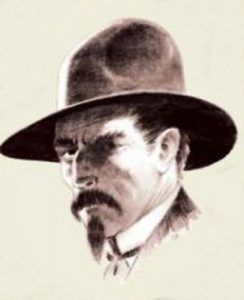
Whispering Smith
A type diametrically opposite to that of the debonair Boone May was Captain Jim Smith, one of the best peace officers the frontier ever knew. Of Captain Smith’s early history nothing was known, except that he had served with great credit as a captain of artillery in the Union Army. He first appeared on the United Pacific during construction days in the late sixties. Serving in various capacities as a railroad detective, marshal, stock inspector, and the like, for eighteen years Captain Smith wrote more red history with his pistol (barring May’s work on the Sioux) than any two men of his time.
The last I knew of him he had enough dead outlaws to his credit — thirty-odd — to start, if not a respectable, at least, a fair-sized graveyard. Captain Jim’s mere look was almost enough to still the heart-beat and paralyze the pistol hand of any but the wildest of them all.
His great burning black eyes, glowering deadly menace from cavernous sockets of extraordinary depth, were set in a colossal grim face; his straight, thin-lipped mouth never showed teeth; his heavy, tight-curling black mustache and stiff black imperial always had the appearance of holding the under lip closely glued to the upper. In years of intimacy, I never once saw on his lips the faintest hint of a smile.
He had a tremendous breadth of shoulders and depth of chest; he was big-boned, lean-loined, quick and furtive of movement as a panther. In short, Captain Jim was altogether the most fearsome-looking man I ever saw, the very incarnation of a relentless, inexorable, indomitable, avenging Nemesis.
Like most men lacking humor, Captain Jim was devoid of vices; like all men lacking sentiment, he cultivated no intimacies. Throughout those years loved nothing, animate or inanimate, but his guns — the full length “45” that nestled in its breast scabbard next his heart, and the short “45,” sawed-off two inches in front of the cylinder, that he always carried in a deep side-pocket of his long sack coat. This was often a much-patched pocket, for Jim was a notable economist of time and usually fired from within the pocket. That he loved those guns I know, for often have I seen him fondle them as tenderly as a mother her first-born.
In 1879 Sidney, Nebraska was a hell-hole, filled with the most desperate toughs come to prey upon overland travelers to and from the Black Hills. Of these toughs, McCarthy, proprietor of the biggest saloon and gambling-house in town, was the leading spirit and boss. Nightly, men who would not gamble were drugged or slugged or leaded. Town marshals came and went — either feet first or on a keen run.
So long as its property remained unmolested the Union Pacific management did not mind. But one night the depot was robbed of sixty thousand dollars in gold bullion. Of course, this was the work of the local gang. Then the Union Pacific. got busy. Pete Shelby summoned Captain Jim to Omaha and committed the Sidney situation to his charge. Frequenting haunts where he knew the news would be wired to Sidney, Jim casually mentioned that he was going out there to clean out the town, and purposed killing McCarthy on sight. This he rightly judged would stampede, or throw a chill into, many of the pikers — and simplify his task.
Arrived in Sidney, Jim found McCarthy absent, at North Platte, due to return the next day. Coming to the station the next morning, Jim found the express reported three hours late, and returned to his room in the railway House, fifty yards north of the depot. He doffed his coat, shoulder scabbard, and boots, and lay down, shortly falling into a doze that nearly cost him his life. Most inconsiderately the train made up nearly an hour of its lost time. Jim’s awakening was sudden, but not soon enough. Before he had time to rise at the sound of the softly opening door, McCarthy was over him with a pistol at his head.
Jim’s left hand nearly touched the gun pocket of his coat, and his right lay in reach of the other gun; but his slightest movement meant instant death.
“Heerd you come to hang my hide up an’ skin the town, but you’re under a copper and my open play wins, Black Jim! See?” growled McCarthy.
“Well, Mac,” coolly answered Jim, “you’re a bigger damn fool than I allowed. Never heard of you before makin’ a killin’ there was nothin’ in. What’s the matter with you and your gang? I’m after that bullion, and I’ve got a straight tip: Lame Johnny’s the bird that hooked onto it. If you’re standing in with him, you better lead me aplenty, for if you don’t I’ll sure get him.”
“Honest? Is that right, Jim? Ain’t lyin’ none?” queried McCarthy, relieved of the belief that his gang were suspected.
“Sure, she’s right, Mac.”
“But I heerd you done said you was comin’ to do me,” persisted McCarthy.
“Think I’m fool enough to light in diggin’ my own grave, by sendin’ love messages like that to a gun expert like you, Mac?” asked Captain Jim.
Whether it was the subtle flattery or Jim’s argument, Mac lowered his gun, and while backing out of the room, remarked: “Nothin’ in mixin’ it with you, Jim, if you don’t want me.”
But Mac was no more than out of the room when Jim slid off the bed quick as a cat; softly as a cat, on his noiseless stockinged feet he followed Mac down the hall; crafty as a cat, he crept down the creaking stairs, tread for tread, a scant arm’s length behind his prey — why, God alone knows, unless for a savage joy in longer holding another thug’s life in his hands. So he hung, like a leech to the blood it loves, across the corridor and to the middle of the trunk room that lay between the hall and the hotel office. There Jim spoke:
“Oh! Mr. McCarthy!”
Mac whirled, drawing his gun, just in time to receive a bullet squarely through the heart.
During the day Jim got two more scalps. The rest of the McCarthy gang got the impression that it was up to them to pull their freight out of Sidney, and acted on it.
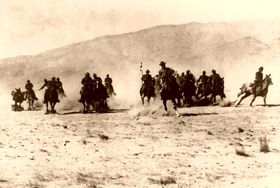
U.S. Cavalry
In 1882 the smoke of the Lincoln County War still hung in the timber of the Ruidoso and the Bonito, a feud in which nearly three hundred New Mexicans lost their lives. Depredations on the Mescalero Reservation were so frequent that the Indians were near open revolt.
Needing a red-blooded agent, the Indian Bureau sought and got one in Major W. H. H. Llewellyn, since Captain of Rough Riders, Troup H, then a United States marshal with a distinguished record. The then Chief of the Bureau offered the Major two troops of cavalry to preserve order among the Mescalero and keep marauders off the reservation, and was astounded when Llewellyn declined and said he would prefer to handle the situation with no other aid than that of one man he had in mind.
Captain Jim Smith was the man. And pleased enough was he when told of the turbulence of the country and the certainty of plenty doing in his line.
But by the time they reached the Mescalero Agency, the feud was ended; the peace of exhaustion after years of open war and ambush had descended upon Lincoln County, and the Mescalero were glad enough quietly to draw their rations of flour and coffee, and range the Sacramentos and Guadalupes for game. For Jim and the band of Indian Police, which he quickly organized, there was nothing doing.
Inaction soon cloyed Captain Jim. It got on his nerves. Presently he conceived a resentment toward the agent for bringing him down there under false pretenses of daring deeds to be done, that never materialized. One day Major Llewellyn imprudently countermanded an order Jim had given his Chief of Police, under conditions which the Captain took as a personal affront. The next thing the Major knew, he was covered by Jim’s gun listening to his death sentence.
“Major,” began Captain Jim, “right here is where you cash in. Played me for a big fool long enough. Toted me off down here on the guarantee of the best show of fightin’ I’ve heard of since the war — here where there ain’t a man in the Territory with nerve enough left to tackle a prairie dog, ‘s far ‘s I can see. Lied to me a plenty, didn’t you? Anything to say before you quit?”
Since that time Major Llewellyn has become (and is now) a famous pleader at the New Mexican bar, but I know he will agree that the most eloquent plea he has t this day made was that in answer to Captain Jim’s arraignment. Luckily it won.
A month later Jim called on me at El Paso. At the time I was President of the West Texas Cattle Growers’ Association, organized chiefly to deal with marauding rustlers.
“Howd’y, Ed,” Jim began, “I’ve jumped the Mescalero Reservation, headed north. Nothin’ doin’ down here now. But, say, Ed, I hear they’re crowdin’ the rustlers a plenty up in the Indian Territory and the Panhandle, and she’s a cinch they’ll be down on you thick in a few months. And, say, Ed, don’t forget old Jim; when the rustlers come, send for him. You know he’s the cheapest proposition ever — never any lawyers’ fees or court costs, nothin’ to pay but just Jim’s wages.”
That was the last time we ever met, and lucky it will probably be for me if we never meet again; for if Jim still lives and there is aught in this story he sees occasion to take exception to, I am sure to be due for a mix-up I can very well get on without.
From 1878 to 1880 Billy Lykins was one of the most efficient inspectors of the Wyoming Stock Growers’ Association, a short man of heavy muscular physique and a round, cherubic, pink and white face, in which a pair of steel-blue glittering eyes looked strangely out of place. A second glance, however, showed behind the smiling mouth a set of the jaw that did not belie the fighting eyes. So far as I can now recall, Billy never failed to get what he went after while he remained in our employ.
Probably the toughest customer Billy ever tackled was Doc Middleton. As an outlaw, Doc was the victim of an error of judgment. When he first came among us, hailing from Llano County, Texas, Doc was as fine a puncher and jolly, good-tempered range-mate as any in the Territory. Sober and industrious, he never drank or gambled. But he had his bit of temper, had Doc, and his chunk of good old Llano nerve. Thus, when a group of carousing soldiers, in a Sidney saloon, one night lit in to beat Doc up with their six-shooters for refusing to drink with them, the inevitable happened in a very few seconds; Doc killed three of them, jumped his horse, and split the wind for the Platte.
And therein lay his error.
The killing was perfectly justifiable; surrendered and tried, he would surely have been acquitted. But his breed never surrenders, at least, never before their last shell is emptied.
Flight having made him an outlaw, the Government offered a heavy reward for him, dead or alive. For a time he was harbored among his friends on the different ranches; indeed was a welcome guest of my Deadman Ranch for several days, but in a few weeks the hue and cry got so hot that he had to jump for the Sand Hills south of the Niobrara.
Ever pursued, he found that honest wage-earning was impossible. Presently he was confronted with want, not of much, indeed of very little, but that want was vital — he wanted cartridges. At this time the Sand Hills were full of deer and antelope; and therefore to him, cartridges meant more even than the defense of his freedom, they meant food. It was this want that drove him into his first actual crime, the stealing of Sioux ponies, which he ran into the settlements and sold.
The downward path of the criminal is like that of the limpid, clean-faced brook, bred of a bubbling spring nestled in some shady nook of the hills, where the air is sweet and pure, and pollution cometh not. But there it may not stay; on and yet on it rushes, as helpless as heedless, till one day it finds itself plunged into some foul current carrying the off-scourings of half a continent. So on and down plunged Doc; from stealing Indian ponies to lifting ranch horses was no long leap in his new code.
Then our stock Association got busy and Billy Lykins took his trail. Oddly, in a few months, the same type of accident, in turn, saved the life of each. Their first encounter was single-handed. With the better horse, Lykins was pressing Doc so close that Doc raced to the crest of a low conical hill, jumped off his mount, dropped flat on the ground and covered Lykins with a Springfield rifle, meantime yelling to him:
“Duck, you little Dutch fool; I don’t want to kill you”; for they knew each other well, and in a way were friends.
But, Billy never knew when to stop. Deeper into his pony’s flank sank the rowels, and up the hill on Doc he charged, pistol in hand. At thirty yards Doc pulled the trigger, when — wonder of wonders—the faithful old Springfield missed fire. Before Doc could throw in another shell or draw his pistol, Billy was over him and had him covered.
If my memory rightly serves, the Sidney jail held Doc almost a fortnight. A few weeks later Doc had assembled a strong gang about him, rendezvoused on the Piney, a tributary of the lower Niobrara. There he was far east of Lykins’s bailiwick, but a good many degrees within Lykins’s disposition to quit his trail. Accompanied by Major W. H. H. Llewellyn and an Omaha detective (inappropriately named Hassard), Lykins located Doc’s camp, and the three lay near for several days studying their quarry.
One morning Llewellyn and Hassard started up the creek, mounted, on a scout, leaving Lykins and his horse hidden in the brush near the trail. At a sharp bend of the path the two ran plunk into Doc and five of his men. Both being unknown to Doc’s gang, and the position and odds forbidding hostilities, they represented themselves as campers hunting lost stock, and turned and rode back down the trail with the outlaws, alert for any play their leader might make.
Recognizing his man, Billy lay with his “45” and “70” Sharps comfortably resting across a log; and when the band came within 20 yards of him, he drew a careful bead on Doc’s head and pulled the trigger. By a strange coincidence, his Sharps missed fire, precisely as had Doc’s Springfield a few weeks before.
Hearing the snap of the rifle hammer, with a curse Doc jerked his gun and whirled his horse toward the brush just as Billy sprang out into the open and threw a pistol shot into Doc that broke his thigh. Swaying in the saddle, Doc cursed Hassard for leading him into a trap and shot him twice before himself pitching to the ground. Hassard stood idly, stunned apparently by a sort of white-hot work he was not used to, and received his death-wound without any effort even to draw. Meantime, the firm of Lykins and Llewellyn accounted for two more before Doc’s mates got out of range. Thus, like the brook, Doc had drifted down the turbid current of crime until he found himself impounded in the Lincoln penitentiary with the off-scourings of the state.
While it is true that back into such impounding most who once have been there soon return, Doc turned out to be one of the rare exceptions proving the rule; for the last I heard of him, he was the lame but light-hearted and wholly honest proprietor of a respectable Rushville saloon.
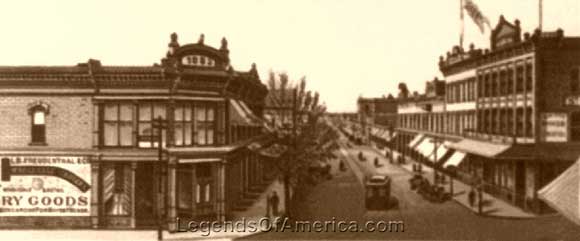
Street in El Paso, Texas, 1888
When in the early 1880’s the front camps of the Atchison, Topeka, and Santa Fe and the Texas Pacific met at El Paso, then a village called Franklin, within a few weeks the population jumped from a few hundred to nearly three thousand. Speculators, prospectors for business opportunities, mechanics, miners, and tourists poured in—a chance-taking, high-living, free-spending lot that offered such rich pickings for the predatory that it was not long before nearly every fat pigeon had a hungry, merciless vulture hovering near, watching for a chance to fasten its claws and gorge itself.
The low one-story adobes, fronted by broad, arched portals, that then lined the west side of El Paso Street for several blocks, was a long solid row of variety theatres, dance halls, saloons, and gambling-houses, never closed by day or by night. They were packed with a roistering mob that drifted from one joint to another, dancing, gambling, carousing, and fighting. Naturally, at first the predatory confined their attentions to the roisterers.
Of course, every layout was a brace game, from which no player arose with any notable winning except occasionally when the “house” felt it a good bit of advertising to graduate a handsome winner — and then it was usually a “capper,” whose gains were in a few minutes passed back into the till.
The faro boxes were full of springs as a watch; faro decks were carefully cut “strippers.” An average good dealer would shuffle and arrange as he liked the favorite cards of known high-rollers. These had been neatly split on either edge and a minute bit of bristle pasted in, which no ordinary touch would feel, but which the sand-papered fingertips of an expert dealer would catch and slip through on the shuffle and place where they would do (the house) the most good. The “tin horns” gave out few but false notes; the roulette balls were kicked silly out of the boxes representing heavily played numbers. Not content with the “Kitty’s” rake-off, every stud poker table had one or more “cappers” sitting in, to whom the dealers could occasionally throw a stiff pot. The backs of poker decks were so cunningly marked that while the wise ones could read their size and suit across the table, no untaught eye could detect their guile. And wherever a notable roll was once flashed, greedy eyes never left it until it was safe in the till of some game, or its owner “rolled” and relieved of it by force.
For months orgy ran riot and the predatory band grew bolder and cruder in their methods. Killings were frequent. Few nights passed without more or less street hold-ups — usually more. Respectable citizens took the middle of the street, literally gun in hand, when forced to be out of nights. The Mayor and City Council were powerless. City marshals and deputies they hired in bunches, but all to no purpose. Each fresh lot of appointees were short-lived, literally or officially — mostly literally. Finally, a vigilance committee was formed, made up of good citizens not a few of whom were gun experts with their own bit of red record. But nothing came of it. The predatories openly flouted and defied them.
On one notable night when the committee were assembled in front of the old Grand Central Hotel, a mob of two hundred toughs lined up before the thirty-odd of the committee and dared them to open the ball; and it was a miracle the little Plaza was not then and there turned into a slaughter pen bloody as the Alamo. It really looked as if nothing short of martial law and a strong body of troops could pacify the town.
But, one night, into the chamber of the City Council stalked a man, the man of the hour, unheralded and unknown. He gave the name of Dallas Stoudenmire.
About all that was ever learned of him was that he hailed from Fort Davis. His type was that of a course, brutal, Germanic gladiator, devoid of strategy; a bluff, stubborn, give-and-take fighter, who drove bull-headed at whatever opposed him. But El Paso soon learned that he could handle his guns with as deadly dexterity as did his forebears their nets and tridents.
Asked his business with the Council, he said he had heard they had failed to find a marshal who could hold the town down, and allowed he’d like to try the job if the Council would make it worth his while. Questioned as to his views, he explained that he was there to make some good money for himself and save the city more; if they would pay him five hundred dollars a month for two months, they could discharge all their deputies and he would go it alone and agree to clear the town of toughs or draw no pay. The Mayor and Council were paralyzed in a double sense: by the wild audacity of this proposal, and by their memory of recent threats of the thug-leaders that they would massacre the Council to a man if any further attempts were made to circumscribe their activities. Some were openly for declining the offer, but in the end, a majority gained heart of Stoudenmire’s own hardihood sufficiently to hire him.
The rest of the night Stoudenmire employed in quietly familiarizing himself with the personnel of the enemy. He lost no time. At daylight the next morning, several notices, manually written in a rude hand and each bearing the signature of the rude hand that wrote it, were found conspicuously posted between Oregon Street and the Plaza. The signature was “Dallas Stoudenmire, City Marshal.”
The notice was brief but pointed:
“Any of the hold-ups named below I find in town after three o’clock to-day, I’m going to kill on sight.”
Then followed seventy names. The list was carefully chosen: all “pikers” and “four-flushers” were omitted; none but the élite of the gun-twirling, black-jack swinging toughs was included. Hardly a single man was named in the list lacking a more or less gory record.
By the toughs, Stoudenmire was taken as a jest, by respectable citizens as a lunatic. Heavy odds were offered that he would not last till noon, with few takers. And yet throughout the morning Stoudenmire quietly walked the streets, unaccompanied save by his two guns and his conspicuously displayed marshal’s star.
Nothing happened until about two o’clock when two men sprang out from ambush behind the big cottonwood tree that then stood on the northeast corner of El Paso and San Antonio Streets, one armed with a shotgun and the other with a pistol, and started to “throw down” on Stoudenmire, who was approaching from the other side of the street. But before either got his artillery into action, the Marshal jerked his two pistols and killed both, then quietly continued his stroll, over their prostrate bodies, and past them, up the street. It was such an obviously workmanlike job that it threw a chill into the hardiest of the sixty-eight survivors, — so much of a chill that, though Stoudenmire paraded streets and threaded saloon and dance-hall throngs all the rest of the afternoon, seeking his prey, not a single man of them could he find; all stayed close in their dens.
But that the thug-leaders were not idle Stoudenmire was not long learning. In the last moments of twilight, just before the pall of night fell upon the town, the Marshal was standing on the east side of El Paso Street, midway between Oregon and San Antonio Streets, no cover within reach of him. Suddenly, without the slightest warning, a heavy fusillade opened on him from the opposite side of the street, a fusillade so heavy it would have decimated a company of infantry. At least a hundred men fired at him at the word, and it was a miracle he did not go down at the first volley. But he was not even scathed.
Drawing his pistols, Stoudenmire marched upon the enemy, slowly but steadily, advancing straight, it seemed, into the jaws of death, but firing with such wonderful rapidity and accuracy that seven of his foes were killed and two wounded in almost as many seconds, although all kept close as possible behind the shelter of the portal columns. And every second he was so engaged, at least a hundred guns, aimed by cruel trained eyes, that scarce ever before had missed whatever they sought to draw a bead on, were pouring out upon him a hell of lead that must have sounded to him like a flight of bees.
But stand his iron nerve and fatal snap-shooting the thugs could not. Before he was halfway across the street, the hostile fire had ceased, and his would-be assassins were flying for the nearest and best cover they could find. Out of the town, they slipped that night, singly and in squads, boarding freight trains north and east, stages west and south, stealing teams and saddle stock, some even hitting the trails afoot, in stark terror of the man. The next morning El Paso found herself evacuated of more than two hundred men who, while they had been for a time her most conspicuous citizens, were such as she was glad enough to spare. In twenty-four hours Dallas Stoudenmire had made his word good and fairly earned his wages; indeed he had accomplished single-handed what the most hopeful El Pasoites had despaired of seeing done with less authority and force than two or three troops of regular cavalry.
Then El Paso settled down to the humdrum but profitable task of laying the foundations for the great metropolis of the Farther Southwest. Since then, an occasional sporadic case of triggerfingeritis has developed in El Paso, usually in an acute form; but never once since the night Stoudenmire turned the El Paso Street Portals into a shambles has it threatened as an epidemic.
Unluckily, Dallas Stoudenmire did not last long to enjoy the glory of his deed. He was a marked man, merely from motives of revenge harbored by friends of the departed (dead or alive), but as a man with a reputation so big as to hang up a rare prize in laurels for any with the strategy and hardihood to down him. It was therefore matter of no general surprise when, a few weeks after his resignation as City Marshal, he fell the victim of a private quarrel.
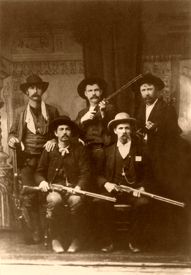
These deputy marshals were sent from the federal court at Fort Smith, Arkansas to capture Ned Christie. Front row, l-r: Charles Copeland, Gideon S. “Cap” White. Back row, l-r: Bill Smith, Bill Ellis, Paden Tolbert, 1892.
A few years later, Hal Gosling was the U. S. Marshall for the Western District of Texas. Early in Gosling’s regime, Johnny Manning became one of his most efficient and trusted deputies. The pair were wide opposites: Gosling, a big, bluff, kindly, rollicking dare-devil afraid of nothing, but a sort that would rather chaff than fight; Manning a quiet, reserved, slender, handsome little man, not so very much bigger than a full-grown “45,” who actually sought no quarrels but would rather fight than eat. Each in his own way, the pair made themselves a holy terror to such of the desperadoes as ventured any liberties with Uncle Sam’s belongings.
One of their notable captures was a brace of road-agents who had appropriated the Concho stage road and about everything of value that traveled it. The two were tried in the Federal Court at Austin and sentenced to hard labor at Huntsville. Gosling and Manning started to escort them to their new field of activity.
Handcuffed but not otherwise shackled, the two prisoners were given a seat together near the middle of a day coach. By permission of the Marshal, the wife of one and the sister of the other sat immediately behind them — dear old Hal Gosling never could resist any appeal to his sympathies.
The seat directly across the aisle from the two prisoners was occupied by Gosling and Manning. With the car well filled with passengers and their men ironed, the Marshal and his Deputy were off their guard. When out of Austin barely an hour, the train at full speed, the two women slipped pistols into the hands of the two convicted bandits, unseen by the officers. But others saw the act, and a stir of alarm among those nearby caused Gosling to whirl in his seat next the aisle, reaching for the pistol in his breast scabbard. But he was too late. Before he was half risen to his feet or his gun out, the prisoners fired and killed him.
Then ensued a terrible duel, begun at little more than arm’s length, between Manning and the two prisoners, who presently began backing toward the rear door. Quickly the car filled with smoke, and in it pandemonium reigned, women screaming, men cursing, all who had not dropped in a faint ducking beneath the car seats and trying their best to burrow in the floor. When at length the two prisoners reached the platform and sprang from the moving train, Johnny Manning, shot full of holes as a sieve, lay unconscious across Hal Gosling’s body; and the sister of one of the bandits hung limp across the back of the seat the prisoners had occupied, dead of a wild shot.
But Johnny had well avenged Hal’s death and his own injuries; one of the prisoners was found dead within a few yards of the track, and the other was captured, mortally wounded, a half-mile away.
After many uncertain weeks, when Manning’s system had successfully recovered from the overdose of lead administered by the departed, he quietly resumed his star and belt, and no one ever discovered that the incident had made him in the least gun-shy.
Whenever the history of the Territory of New Mexico comes to be written, the name of Colonel Albert J. Fountain deserves and should have first place in it. Throughout the formative epoch of her evolution from semi-savagery to civilization, an epoch spanning the years from 1866 to 1896, Colonel Fountain was far and away her most distinguished and most useful citizen.
As soldier, scholar, dramatist, lawyer, prosecutor, Indian fighter, and desperado-hunter, his was the most picturesque personality I have ever known. Gentle and kind-hearted as a woman, a lover of his books and his ease, he nevertheless was always as quick to take up arms and undergo any hazard and hardship in pursuit of murderous rustlers as he was in 1861 to join the California Column (First California Volunteers) on its march across the burning deserts of Arizona to meet and defeat Sibley at Val Verde. A face fuller of the humanities and charities of life than his would be hard to find; but, roused, the laughing eyes shone cold as a wintry sky. He despised wrong, and hated the criminal, and spent his whole life trying to right the one and suppress or exterminate the other. In this work, and of it, ultimately, he lost his life.
In the early eighties, while the New Mexican courts were well-nigh idle, crime was rampant, especially in Lincoln, Dona Ana, and Grant Counties. To the east of the Rio Grande the Lincoln County War was at its height, while to the west the John Kinney Gang took whatever they wanted at the muzzle of their guns; and they wanted about everything in sight. County peace officers were powerless.
At this stage, Fountain was appointed by the Governor “Colonel of State Militia,” and given a free hand to pacify the country. As an organized military body, the militia existed only in name. And so Fountain left it. Serious and effective as was his work, no man loved a grand-stand play more than he. He liked to go it alone, to be the only thing in the spotlight. Thus most of his work as a desperado-hunter was done single-handed.
On only one occasion that I can recall did he ever have with him on his raids more than one or two men, always Mexicans, temporarily deputized. That was when he met and cleaned out the Kinney gang over on the Miembres, and did it with half the number of the men he was after.
Among those who escaped was Kinney’s lieutenant. A few weeks later Colonel Fountain learned that this man was in hiding at Concordia, a placita two miles below El Paso. He was one of the most desperate Mexican outlaws the border has ever known, a man who had boasted he would never be taken alive, and that he would kill Fountain before he was himself taken dead, a human tiger, whom the bravest peace officer might be pardoned for wanting a great deal of help to take. Yet Fountain merely took his armory’s best and undertook it alone: and by mid-afternoon of the very next day after the information reached him, he had his man safely manacled at the El Paso depot of the Santa Fe Railway.
While waiting for the train, Colonel George Baylor, the famous Captain of Texas Rangers, chided Fountain for not wearing a cord to fasten his pistol to his belt, as then did all the Rangers, to prevent its loss from the scabbard in a running fight; and he finished by detaching his own cord, and looping one end to Fountain’s belt and the other to his pistol. Then Fountain bade his old friend good-bye and boarded the train with his prisoner, taking a seat near the center of the rear car.
When well north of Canutillo and near the site of old Fillmore, Fountain rose and passed forward to speak to a friend who was sitting a few seats in front of him, a safe enough proceeding, apparently, with his prisoner handcuffed and the train doing thirty-five miles an hour. But scarcely had he reached his friend’s side when a noise behind him caused him turn — just in time to see his Mexican running for the rear door. Instantly Fountain sprang after him before he got to the door the man had leaped from the platform. Without the slightest hesitation, Fountain jumped after him, hitting the ground only a few seconds behind him but thirty or forty yards away, rolling like a tumbleweed along the ground. By the time Fountain had regained his feet, his prisoner was running at top speed for the mesquite thickets lining the river, in whose shadows he must soon disappear, for it was already dusk. Reaching for his pistol and finding it gone — lost evidently in the tumble — and fearing to lose his prisoner entirely if he stopped to hunt for it, Fountain hit the best pace he could in pursuit. But almost at the first jump something gave him a thump on the shin that nearly broke it, and, looking down, there, dangling on Colonel Baylor’s pistol-cord, he saw his gun.
Always a cunning strategist, Fountain dropped to the ground, sky-lined his man on the crest of a little hillock he had to cross, and took a careful two-handed aim which enabled Rio Grande ranchers thereafter to sleep easier of nights.
And now, just as I am finishing this story, the wires bring the sad news that dear old Pat Garrett, the dean and almost the last survivor of the famous man-hunted of west Texas and New Mexico, has gone the way of his kind — “died with his boots on.” I cannot help believing that he was the victim of a foul shot, for in his personal relations I never knew him to court a quarrel or fail to get an adversary. Many a night we have camped, eaten, and slept together. Barring Colonel Fountain, Pat Garrett had stronger intellectuality and broader sympathies than any of his kind I ever met. He could no more do enough for a friend than he could do enough to an outlaw. In his private affairs so easy-going that he began and ended a ne’er-do-well, in his official duties as a peace officer he was so exacting and painstaking that he ne’er did ill. His many intrepid deeds are too well known to need recounting here.
All his life an atheist, he was as stubbornly contentious for his unbelief as any Scotch Covenanter for his best-loved tenets.
Now, laid for his last rest in the little burying-ground of Las Cruces, a tiny, white-paled square of sandy, hummocky bench land where the pink of fragile nopal petals brightens the graves in Spring and the mesquite showers them with its golden pods in Summer; where the sweet scent of the juajilla loads the air, and the sun ever shines down out of a bright and cloudless sky; where a diminutive forest of crosses of wood and stone symbolize the faith he in life refused to accept — now, perhaps, Pat Garrett has learned how widely he was wrong.
Peace to his ashes, and repose to his dauntless spirit!
By Edgar Beecher Bronson in 1910. Compiled and edited by Kathy Weiser/Legends of America, updated February 2020.
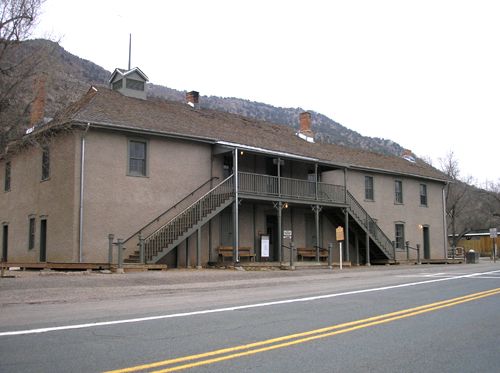
The Murphy & Dolan Mercantile in Lincoln, New Mexico would later become the Lincoln County Courthouse
About the Author: Edgar Beecher Bronson was the author of The Red-Blooded Heroes of the Frontier. Triggerfingeritis is a chapter of this book, published by A. C. Mcclurg & Co. in 1910. Bronson worked not only as a reporter and a writer, publishing a number of books and articles, he was also a cowboy and a rancher. The text as it appears here; is not verbatim as it has been edited for clarity and ease of the modern reader.
Also See:
A Cow Hunter’s Court by Edgar Bronson

